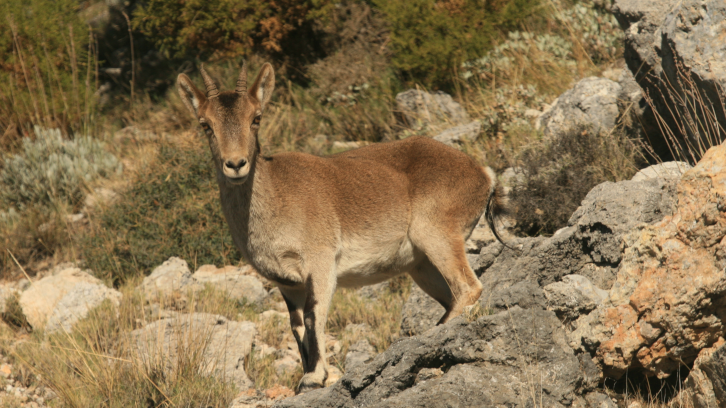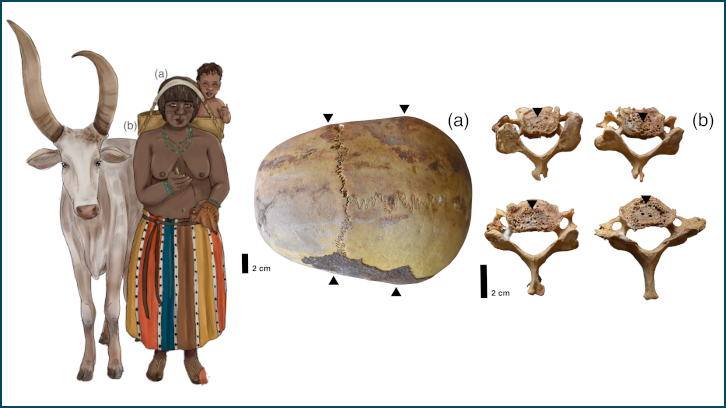Mountain ecosystems protect Iberian ibex from parasites transmitted by cats and dogs

Wild ruminants can be affected by parasites transmitted by cats and dogs. A recent study assessed the risk to the Iberian ibex population in Sierra Nevada and found no evidence of contact, likely due to the low presence of cats and dogs or the harsh environmental conditions for parasite survival. Nevertheless, continued monitoring is recommended in light of potential increases in human activity and global warming.
Domestic cats and dogs are the main definitive hosts of the parasites Toxoplasma gondii and Neospora caninum, respectively. Both carnivores can transmit these parasites to other animal species, both domestic and wild, and, in the case of T. gondii, also to humans, causing mainly reproductive problems. Both protozoa are transmitted through the elimination of infective forms (oocysts) through the faeces of the definitive hosts, infecting other animal species when they ingest the oocysts present in the environment. These parasites can therefore affect wild ruminant populations, such as the Iberian ibex, a species endemic to the mountain ranges of the Iberian Peninsula, including Sierra Nevada (eastern Andalusia), the southernmost high mountain ecosystem in Europe.
To assess the risk that these parasites may pose to the Sierra Nevada ibex population, we analysed 146 serum samples from ibexes captured in the Espacio Natural de Sierra Nevada (ENSN) from 2010 to 2015. Two different serological diagnostic techniques (ELISA and Western Blot) were used to detect antibodies against each of the two parasites, as the methodologies are not validated for this species, and, therefore, the results obtained using only one of these techniques may not be reliable.
Although the less specific ELISA technique detected antibodies against T. gondii and N. caninum in 11.6% and 4.8% of ibexes, respectively, the Western Blot technique did not confirm any of these positive results. This lack of concordance between techniques suggests that the positivity detected by ELISA was due to false positives (i.e., uninfected animals with a positive result). The results suggest that the Sierra Nevada ibex population is apparently free from contact with these two parasites.
The ENSN, and especially its central core, the Sierra Nevada National Park, is a high-mountain area with a high level of protection where the definitive hosts of T. gondii (cats) and N. caninum (dogs) are scarce. This is possibly the main reason for the lack of detection of these parasites in the ibexes of the ENSN. Furthermore, the environmental conditions of the high mountains reduce the survival of the oocysts of these parasites in the environment, decreasing their possibility of transmission. However, this situation could change in the future if human activity continues to rise, and with it, the presence of cats and dogs in high-mountain ecosystems increases also. Furthermore, global warming is increasing temperatures and decreasing snow cover in the Sierra Nevada, which could favour the survival of infective forms of T. gondii and N. caninum in this mountain ecosystem.
Therefore, it is advisable to continue monitoring T. gondii and N. caninum in the Sierra Nevada as part of the health surveillance of the Iberian ibex, a useful species as an environmental health sentinel, and to detect human-induced changes in this high-mountain ecosystem.
Alejandro Cano-Manuel, Carlos Martínez-Carrasco
Department of Animal Health
Universidad de Murcia
a.cano-manuel@correo.gob.es, cmcpleit@um.es
José Enrique Granados
Grupo de investigación RNM118
Parque Nacional y Parque Natural Sierra Nevada
josee.granados@juntadeandalucia.es
Gregorio Mentaberre
Department of Animal Science
Wildlife Ecology & Health group (WE&H)
Universitat de Lleida
gregorio.mentaberre@udl.cat
Jorge Ramón López-Olvera
Department of Animal Medicine and Surgery
Servei d’Ecopatologia de Fauna Salvatge (SEFaS)
Wildlife Ecology & Health group (WE&H)
Universitat Autònoma de Barcelona
References
Cano-Manuel, A.; Granados, J. E.; Álvarez-García, G.; Huertas-López, A.; Diezma-Díaz, C.; Cano-Manuel, F. J.; Ortega-Mora, L. M.; Fandos, P.; Mentaberre, G.; López-Olvera, J. R.; Martínez-Carrasco, C. (2025). Seronegativity of Iberian ibex (Capra pyrenaica) against Toxoplasma gondii and Neospora caninum is consistent with eco-epidemiological and environmental features in Mediterranean mountainous areas. Research in Veterinary Science 184: 105530. https://doi.org/10.1016/j.rvsc.2025.105530


